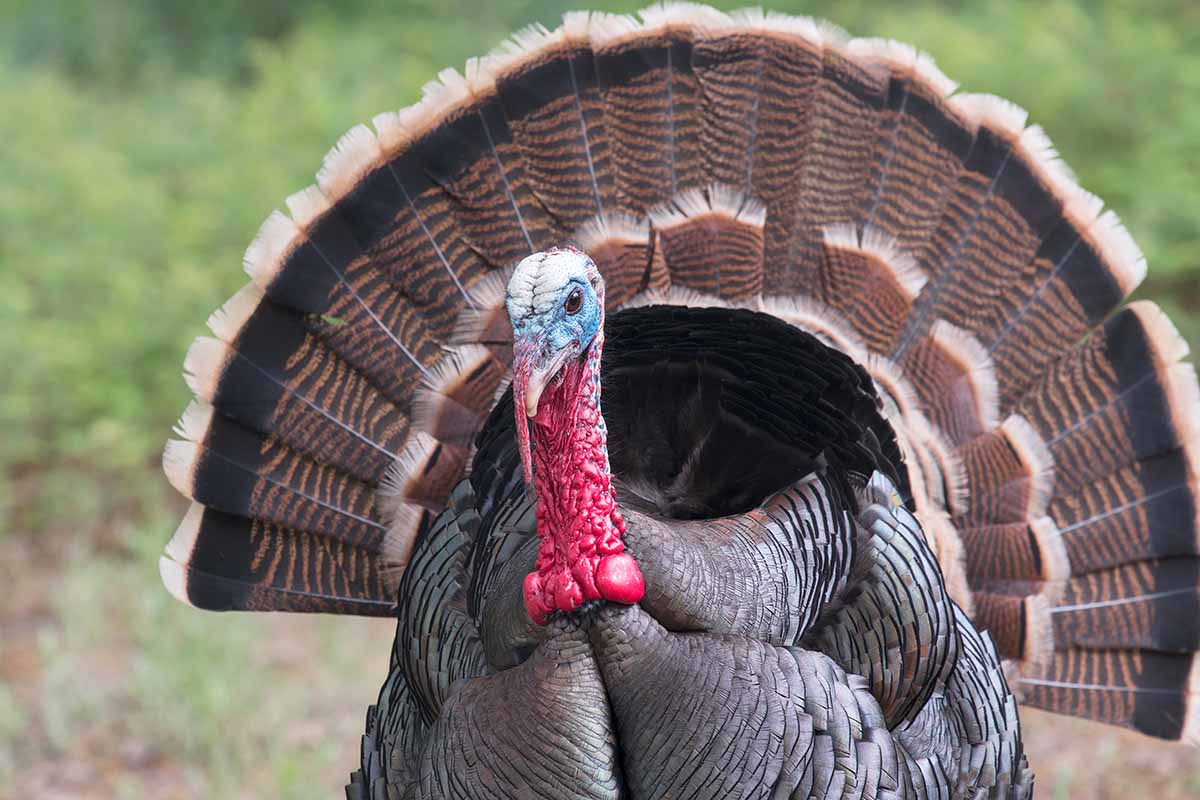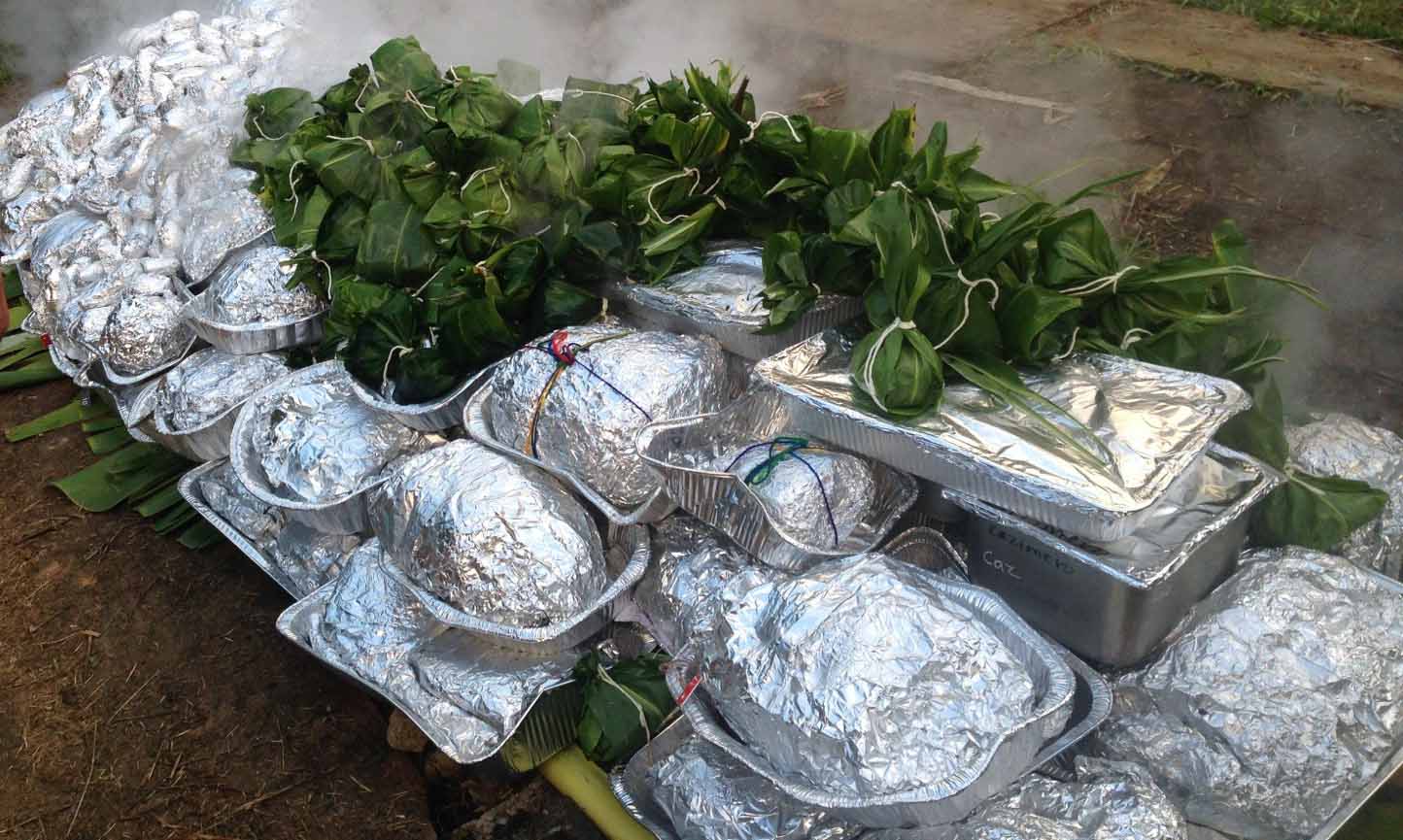
November is here, and for most of us, it’s time to plan a family feast for a grateful gathering. And, whether your table holds laulau or green bean casserole, purple or orange sweet potatoes, pumpkin mochi, pie, or crunch, chances are the centerpiece is going to be a nice roast turkey.
Wild turkeys are plentiful on Hawai’i Island, where they thrive in upper elevations, dining on green plant shoots, seeds, berries, small lizards, and the occasional centipede. They’re no dummies, however, and have taken to hanging out at the coastal resorts and golf courses, where food and beverage is five-star.
But how did turkeys get to Hawai‘i in the first place?
It’s a long story, and a long journey, that starts somewhere in South America. Here, “feathered dinosaurs” lived and thrived about 20 million years ago. Fast forward to the first century AD, when turkeys had evolved into a smaller and tastier species, and Mexican Aztecs first domesticated them. The wild species spread into North America.
According to the National Wildlife Federation, “Spanish explorers took some of these back to Europe in the mid-16th Century where they became common farmyard animals. These domestic turkeys eventually completed the circuit and came back to North American turkey farms from Europe.”
The English may have called turkeys turkeys because they came by way of the trade routes, through the Ottoman Empire (where the Turks lived). But, according to Dictionary.com, “Every language seems to have radically different names for what we call a turkey. The Turkish word for a turkey is hindi, which literally means ‘Indian.’ The original word in French, coq d’Inde, meant ‘rooster of India,’ and has since shortened to dinde… In Portuguese, it’s literally a ‘Peru bird,’ and in Malay, it’s called a ‘Dutch chicken.’ This bird, which originates in one region, certainly has globe-trotting names!”
Domestic turkeys may have come to the continent with early European settlers, but we know wild turkeys were already there. They had been a healthy, highly valued species to Native American culture and cuisine for hundreds of years. The large, beautiful birds were amazing, able to fly 55 mph and run 25 mph. Their feathers had a bluish-coppery sheen that the males would fan into a fabulous display when trying to impress the hens. Their bare heads could change from bright red to to blue, depending on the mood; they boasted large wattles, snoods and beards; and their “domination dance” was a stellar performance.
As so many stories go, the wild turkeys were hunted nearly to extinction by non-natives. Ironically, many years later, it was hunters who helped restore their population in North America.
Turkey = Pelehū

Thanksgiving Turkey Imu – Photo courtesy Island Partners Hawai’i
The first mention of turkeys coming to Hawai’i, was in 1788, as they boarded on a ship as gifts for a Kauai chief named Ka‘iana. He was voyaging with Captain John Meares aboard the Nootka. After spending time in China—where he was very popular—Ka‘iana was generously gifted with “with whatever could be useful or acceptable; such as bulls, cows, sheep, goats, rabbits, turkies (sic), with oranges, mangoes, and various kinds of plants; so that his safe arrival with his cargo would prove of the utmost value to his country.”
However, upon returning to Kawaihae, no birds. The crew unloaded, “’saws of different kinds, gimblets, hatchets, adzes, knives and choppers, cloth of various fabrics, carpets of several colours, a considerable quantity of China-ware, and ten bars of iron.’ Apparently, the live animals and plants that had been loaded in China were casualties of the early tribulations of the voyage.” (Or the hungry stomachs of the sailors.)*
Apparently, in 1815 a group of domestic turkeys was brought to Hawai‘i from Chile, and we know turkeys were raised by John Palmer Parker at his Mana property in the early 19th century. According to Dr. Bergin in Loyal to the Land V2. “Chickens and turkeys scurried about the ranch headquarters paddock, providing an adequate supply of eggs. The turkeys were converted to roasters and eventually went wild, now abounding in the in the countryside of Waimea in full pomp and gobble.”
In the mid-20th century, hunters introduced turkeys as game birds several times. (Laurance S. Rockefeller may have brought in turkeys in order to offer bird hunting for his guests at Mauna Kea Beach Hotel). About this time a group of 400 wild “Rio Grande” turkeys from Texas were released at Pu‘uwa‘awa‘a Ranch. The Rio Grande thrived, and remains the predominant wild turkey species here today—as many as 18,000 birds in the state.
As a side note, one other species of Wild Turkey can be found at island retailers. As the story goes, a Kentucky distiller was hunting—turkeys of course—with a group of friends. In the evening, he shared some of his new Bourbon… and the rest is history.
Get Yours
- Turkey hunting season is March 1 to April 15, and early November to January 31 annually. Licensing and other information is available from the Hawai’i Department of Land and Natural Resources.
- If you are in need of archery or firearms equipment, C&S Hunting Supplies in Waimea is an excellent source, and owner D’Armand Cook a reliable source of local knowledge.
- Parker Ranch manages the Rio Grande turkey population on its 130,000 acres, and offers guided hunting tours in season. You can also book tours with several of the island’s activities and adventure companies.
- If hunting isn’t your thing, you can now buy farm-raised turkeys from a local enterprises, like PunaChicks in Kurtistown. A limited number of turkeys are raised for the holiday season, and they must be ordered in advance. (Already sold out for 2023).
- A fun way to get your turkey cooked for you is to sign up for a community event. Local charities or schools, for example, will sell tickets for folks to bring their own bird—or ham, ‘ulu, laulau or anything else you’d like to slow-roast in an underground oven.
- And, if you don’t have time to cook in an imu and you’d like to add a local-style flavor to your feast this year, here’s a recipe for Kalua Turkey in the pressure cooker.
Any way you slice it, we hope your turkey feast is a fabulous occasion for family and friends. Enjoy!
SOURCES
*The Hawaiian Journal of History Vol 22 – David G Miller (1988)
